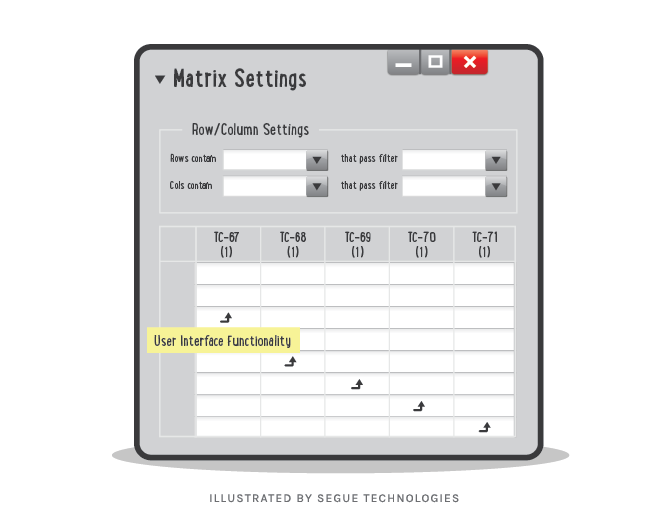Here at Segue we know that traceability is a significant factor in assuring quality software implementation. That is why we have embedded the process of tracing artifacts through the stages of specification, architecture, design, implementation, and testing within our software development process. Segue has a commitment to our clients to provide quality products, and in order to deliver on this promise, we use traceability to help us verify and validate that we are providing high-quality products per our clients’ needs.

This blog article describes what requirements traceability is, how it supports Quality Assurance, and Segue’s chosen automated requirements traceability tool, TestTrack.
What is Requirements Traceability?
Traceability is a powerful tool that enables a development team to easily point out the impact of a particular defect, address the impact, and ensure that the project is in accordance with the objectives. It provides the easiest means of ensuring that the right software is developed. To do so effectively and efficiently, you must choose a flexible tool with built in automation to help you effortlessly maintain traceability.
Traceability involves defining requirements, capturing those requirements, and following links between requirements and other artifacts such as test cases, test runs, defects, and source code files, in the project.
Linking artifacts is very important. The downstream artifacts are routed from the requirements and are directly used to evaluate success or failure. Since all steps from the requirements are linked, successful evaluations of those artifacts show that all the requirements have been met.
How Does Requirements Traceability Work?
Once a project requirement has been finalized and approved, it is subjected to a test and validation process to ensure that the project actually meets those requirements. Test cases are normally done more than one time. If the test case fails, a defect is recorded, and the system is routed back to the developer to fix it. Once the developer fixes the source code, it is checked into the source code management. The source code that required fixing is linked to its resulting defect while the code check is in progress, which also marks the defect as ready for the tester verification.
With the help of traceability links, the tester will easily know which tests need to be rerun. Once the fix is verified, the defect is also marked and fixed. Since the defect was linked to execution results, which were linked to a test case, which in turn was linked to the requirement, the project managers will know that all the requirements have been implemented and verified.
When using traceability, you need to manage a number of things, including creating links and maintaining them across all the product development artifacts. You also need to trace the links upstream and downstream to ensure that you understand the impacts that requirements have on a deliverable. Creating and maintaining links are normally time-consuming and end up adding overhead to the project but using a tool with automated traceability alleviates this issue.
Tracing Artifacts in TestTrack
TestTrack is the most suitable solution for managing product development phases and artifacts. It is useful from the requirement phase, through development phase, to the planning and execution phase. During the requirement phase, TestTrack provides a collaborative solution for capturing and testing requirements. It handles all aspects of requirement management such as planning, traceability, workflow, review, reporting, and management review. During the development phase, TestTrack proves a vital tool for tracking and automating workflow to ensure that all the defects are a part of the test track, features requested are taken care of, and the whole task is done as the schedule. Finally, during the test case management, the TestTrack assists the managers in ensuring that all aspects of the system testing process is done thoroughly.
Tracing artifacts using TestTrack is easy and simple. For instance you can create and manage requirement hierarchically, and organize them in such a way that defines the product you are developing. Since the requirements are put in a hierarchical manner, they are automatically related to their parent requirements. When the child requirements are modified or are not yet met, the hierarchical relationship of the parent is also marked as suspect. The child-parent relationship can easily be represented though a hierarchical structure of the document and linking it automatically. TestTrack also enables you to setup up workflows that automatically create links between artifacts. Seapine’s TestTrack Tools are instrumental in Segue’s project planning and execution activities.